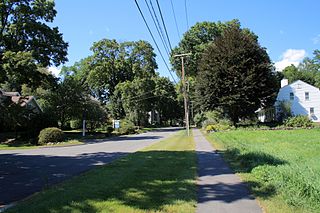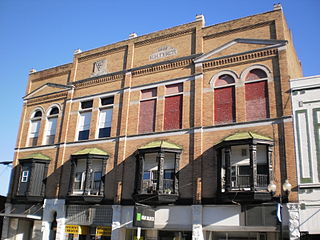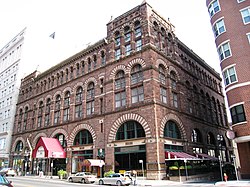
The Old Market is a neighborhood located in downtown Omaha, Nebraska, United States, and is bordered by South 10th Street to the east, 13th Street to the west, Farnam Street to the north and Jackson Street to the South. The neighborhood has many restaurants, art galleries and upscale shopping. The area retains its brick paved streets from the turn of the 20th century, horse-drawn carriages, and covered sidewalks in some areas. It is not uncommon to see a variety of street performers, artists, and other vendors.

G. Fox & Co. was a large department store that originated in Hartford, Connecticut. The store was also the largest privately held department store in the nation when it was sold in 1965 to the May Department Stores Company. In 1993, May Department stores phased-out the G. Fox & Co. name converting them into the Boston-based department store Filene's. In 2005, the May Company merged with Federated Department Stores which converted the store and several other regional chains to Macy's.
Sage-Allen was a mid-market department store chain based in Hartford, Connecticut. The store was a fixture in southern New England and anchored a number of smaller local and regional shopping centers in Connecticut, Massachusetts and, later, New Hampshire, until it ceased operation in 1994.

The Colt Armory is a historic factory complex for the manufacture of firearms, created by Samuel Colt. It is located in Hartford, Connecticut along the Connecticut River, and as of 2008 is part of the Coltsville Historic District, named a National Historic Landmark District. It is slated to become part of Coltsville National Historical Park, now undergoing planning by the National Park Service.

The R. and F. Cheney Building, also known as the Brown Thomson Building, is a commercial building designed by noted American architect H. H. Richardson. It is located at 942 Main Street, Hartford, Connecticut, and is now on the National Register of Historic Places.

280 Broadway – also known as the A.T. Stewart Dry Goods Store, the Marble Palace, and the Sun Building – is a historic building located between Chambers and Reade Streets in the Civic Center district of Manhattan, New York City. Built in 1845-1846, it was the first commercial building in the Italianate style in New York City, and is considered the site of one of the nation's first department stores. 280 Broadway was designed by John B. Snook of Joseph Trench & Company, with later additions by other architects. It was built for the A. T. Stewart Company, which opened New York's first department store in it. It later housed the original New York Sun newspaper (1833–1950) and is now the central offices for the New York City Department of Buildings.

The Cheney Brothers Historic District was a center of the silk industry in Manchester, Connecticut, in the late 19th and early 20th century. The 175-acre (71 ha) district in includes over 275 mill buildings, workers houses, churches, schools and Cheney family mansions. These structures represent the well-preserved company town of the Cheney Brothers silk manufacturing company, the first America-based silk company to properly raise and process silkworms, and to develop the difficult techniques of spinning and weaving silk. The area was declared a National Historic Landmark in 1978.

The Farmington Historic District encompasses a 275-acre (111 ha) area of the town center of Farmington, Connecticut. It was listed on the National Register of Historic Places in 1972. The area roughly corresponds to the section of Route 10 between Route 4 and U.S. Route 6, and includes 115 buildings, primarily residences, built before 1835. The district includes several National Historic Landmarks, include Hill-Stead, the Austin F. Williams Carriagehouse and House, the First Church of Christ, Congregational, and the Stanley-Whitman House.

Stone Street is a short street in the Financial District of Manhattan in New York City. It runs in two sections between Whitehall Street in the west and Hanover Square in the east. The street originally ran as one continuous roadway from Whitehall Street to Hanover Square, but the section between Broad Street and Coenties Alley was eliminated in 1980 to make way for the Goldman Sachs building at 85 Broad Street. The one-block-long western section between Whitehall and Broad Streets carries vehicular traffic, while the two-block-long eastern section between Coenties Alley and Hanover Square is a pedestrian zone.

This is a list of properties on the National Register of Historic Places in Hartford, Connecticut.

Downtown Hartford, Connecticut is the primary business district and the center of Connecticut's state government. Due to the large number of insurance companies headquartered downtown, Hartford is known as the "Insurance Capital of the World".

The Fourth Congregational Church, also known historically as the Horace Bushnell Congregational Church and now as the Liberty Christian Center International, is a historic church at Albany Avenue and Vine Street in Hartford, Connecticut. The church building was built in 1913-14 using parts of an older Greek Revival church, and was listed on the National Register of Historic Places in 1982 for its architecture and role in local historical preservation efforts.

Valparaiso has retained an active downtown. It remains a mix of government, retail and business center, with a mixed residential and service area. Numerous economic changes have not changed the basic character, historic courthouse area. The historic district retains the distinctive turn-of-the-19th-century architecture, supporting numerous small specialty shops, shaded sidewalks, and a people friendly environment. The Downtown District, is anchored on the Porter County Courthouse. It includes 14-blocks surrounding the square, bounded on the north by Jefferson Street, on the east by Morgan Street, on the south by Monroe Street, and on the west by Napoleon Street.

The Hartford City Courthouse Square Historic District is located in Hartford City, Indiana. Hartford City has a population of about 7,000 and is the county seat of Blackford County and the site of the county courthouse. The National Park Service of the United States Department of the Interior added the Hartford City Courthouse Square Historic District to the National Register of Historic Places on June 21, 2006 — meaning the buildings and objects that contribute to the continuity of the district are worthy of preservation because of their historical and architectural significance. The District has over 60 resources, including over 40 contributing buildings, over 10 non-contributing buildings, 1 contributing object, 8 non-contributing objects, and two other buildings that are listed separately in the National Register.

The Downtown Waterbury Historic District is the core of the city of Waterbury, Connecticut, United States. It is a roughly rectangular area centered on West Main Street and Waterbury Green, the remnant of the original town commons, which has been called "one of the most attractive downtown parks in New England."

Fayetteville Historic District is located in Fayetteville, Texas. The small town of Fayetteville is in rural south east central Texas midway between Houston and Austin. The oldest extant building in the district was constructed in 1853. The historic district represents most of the development within town boundaries as indicated by street signs, the boundaries have been drawn to exclude some areas in town occupied primarily by construction from after 1958. The area of the district is 153.5 acres (62.1 ha) and includes 345 properties considered historical and largely intact. An additional 137 properties within district boundaries are not considered for contribution to the historic status of the district. It was added to the National Register of Historic Places (NRHP) on July 10, 2008.

The Hartford Municipal Building, also known as Hartford City Hall, is a historic Beaux-Arts structure located at 550 Main Street in Hartford, Connecticut. Completed in 1915, it is a prominent local example of Beaux-Arts architecture, and is the third building to serve as city hall. It was added to the National Register of Historic Places in 1981.

The Amos Bull House is a historic house at 59 South Prospect Street in Hartford, Connecticut. Built about 1788, it is one of only a few surviving 18th-century buildings in the city. It was listed on the National Register of Historic Places in 1968. It presently houses the main offices of Connecticut Landmarks, a historic preservation organization.

The Isham-Terry House is a historic house museum at 211 High Street in Hartford, Connecticut. Built around 1854, from 1896 it was home to members of the Isham family, who restored it in the early 20th century. The family donated the property to Connecticut Landmarks in the 1970s, which now operates it has a museum, offering guided tours and facility event rentals. The house was listed on the National Register of Historic Places in 1982.

The Manchester Historic District encompasses a historic planned industrial and residential area of Manchester, Connecticut. Located west of the town's Main Street area, the district includes most of the Cheney Brothers Historic District, a National Historic Landmark District covering the silk manufacturing mills, worker housing, and owner residences of the Cheney family, as well as other surrounding residential areas related to the growth and development of Manchester under the Cheney's influence. The district was listed on the National Register of Historic Places in 2000.




















